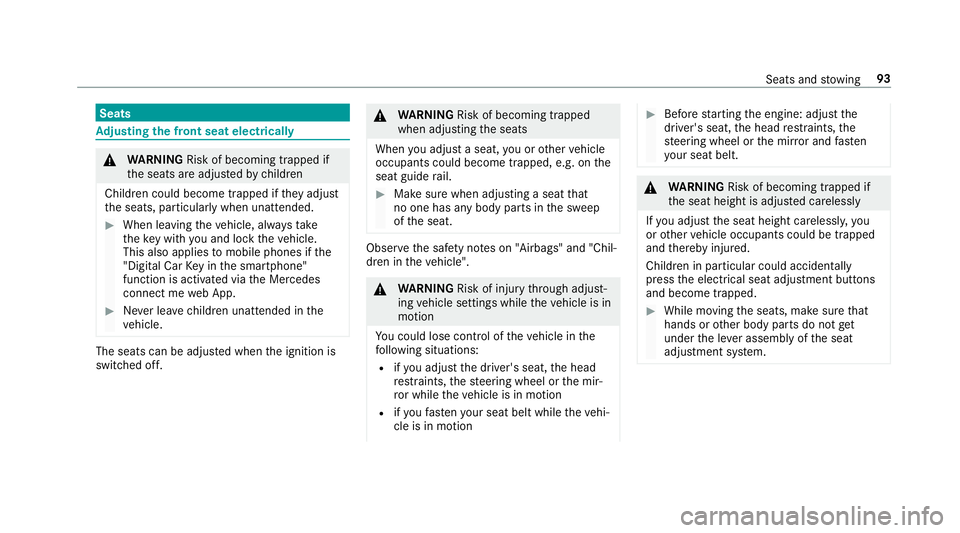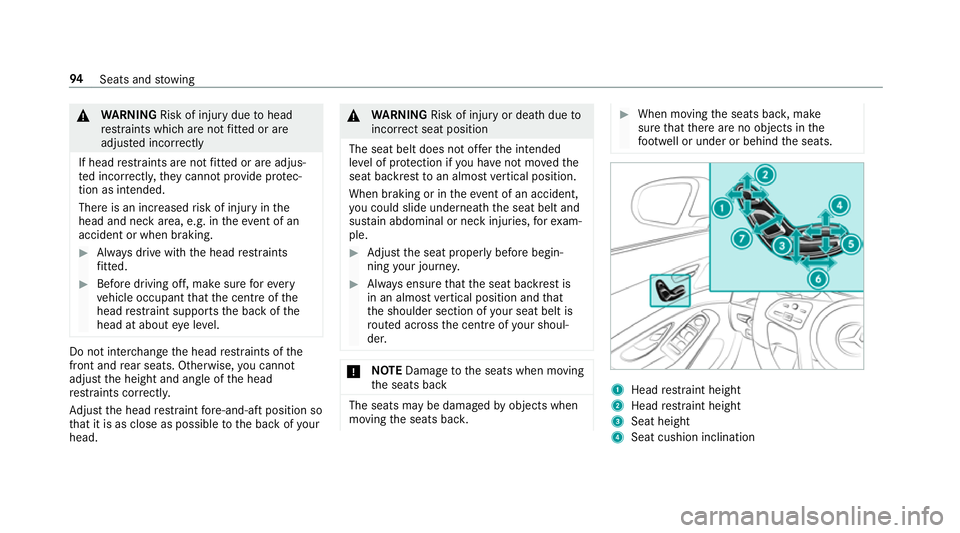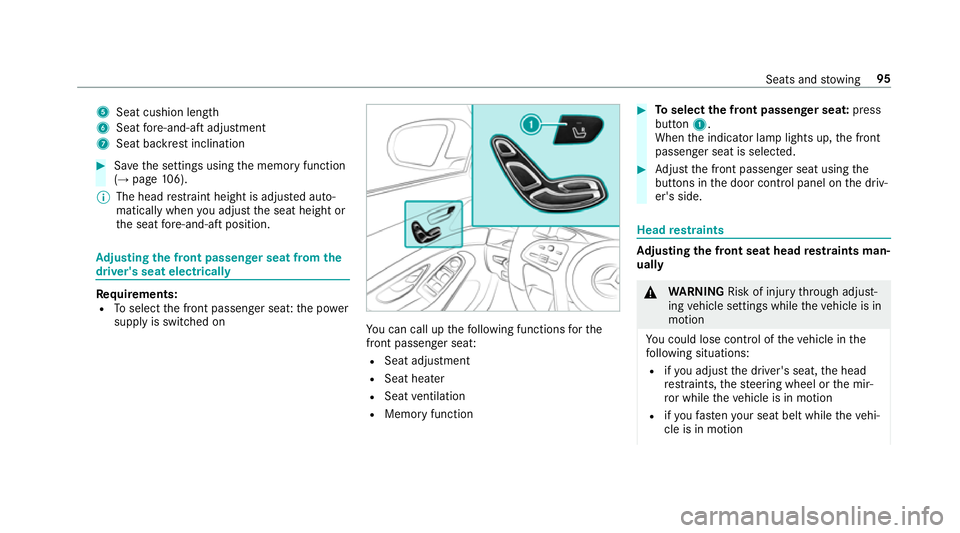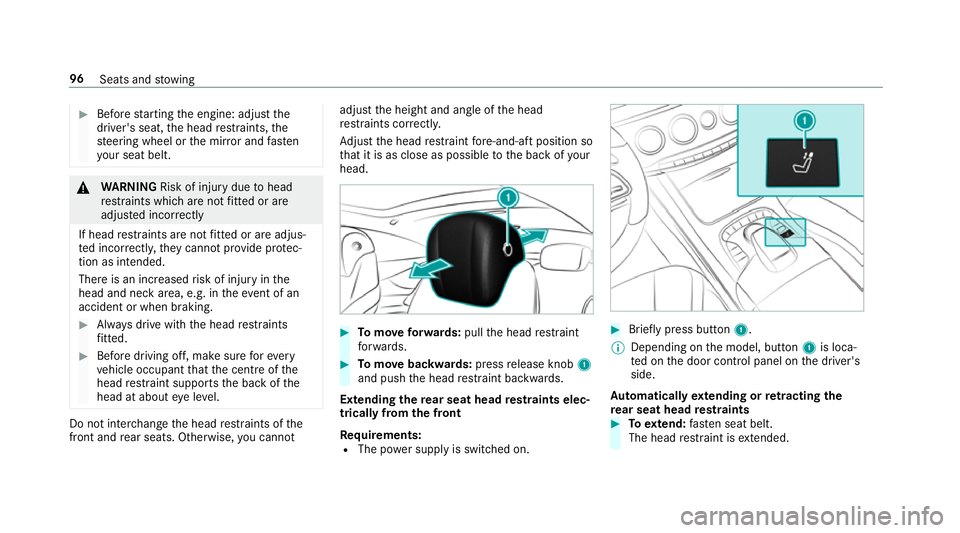2017 MERCEDES-BENZ S-CLASS CABRIOLET height
[x] Cancel search: heightPage 54 of 521

function is activated via
theM ercedes
me connect weba pp. &
WARNING Thisp oses an increased risk
of deat hduetoheat strokeorexposure
to cold in thev ehicle
If persons –particularly children –expe ri‐
enc eprolonged exposur etoextremely high
or lo wtemperatures, this poses arisk of
inju ryor eve nfatal injur y. #
Neverlea ve anyone –p articularly chil‐
dren –unat tende dint hevehicle. &
WARNING Risk of bu rnsw hen thec hild
seat is exposed todirect sunlight
If th ec hild restra int sy stem is exposed to
direct sunlight or heat, parts could heat up.
Children could suf ferb urns on these parts,
particularly on me tallic parts of thec hild
re stra int sy stem. #
Alw aysm akes uret hat thec hild
re stra int sy stem is no texpose dto
direct sunlight. #
Protect it wit hablanket,for example. #
Ifth ec hild restra int sy stem has been
ex posed todirect sunlight ,allowitto
cool befor esecu ring achild int oit. #
Neverlea ve children unat tende dint he
ve hicle. To
impr oveprotection forc hildren younger than
12 yearso ld or unde r1.50 minh eight,
Mercedes-Benz recommends youo bse rvet he
fo llowing information:
R Onlysecur echildren using achild restra int
sy stem whic hisappropriat etothe height,
ag ea nd weight of thec hild and suitable for
Mercedes-Benzv ehicles. Be suretoobserve
th ei nstruction sfor cor rect us eoft hechild
re stra int sy stem.
R Alw aysi ns tallac hild restra int sy stem on a
re ar seat if possible.
R Onlyuse thef ollowing securing sy stems for
ch ild restra int sy stems: -
thes eat belt sy stem
- theI SOFIX mounting brac kets
R The manufactu rer's ins tallation instructions
fo rt he child restra int sy stem.
R The warning labels in thev ehicle interior and
on thec hild restra int sy stem. &
WARNING Risk of inju ryor deat hcaused
by incor rect ins tallation of thec hild
re stra int sy stem
If th ec hild restra int sy stem is incor rectly
ins talled on asuitable seatin gposition, it
canno tperform its intended pr otectiv efunc‐
tion.
The child canno tberestrained in thee vent of
an accident, heavy braking or asudden
ch ang eofd irection. #
Alw aysc ompl ywitht he manufacturer's
ins tallation instructions fort he child
re stra int sy stem and its cor rect use. #
Makesur ethat thee ntir ebase of the
ch ild restra int sy stem alw aysr ests on
th es itting sur face of thes eat. Occupant saf
ety51
Page 96 of 521

Seats
Ad
justin gthe fron tseate lect rica lly &
WARNING Risk of becoming trapped if
th es eats ar eadjus tedbyc hildren
Childre ncould becom etrapped if they adjust
th es eats, particularly when unattended. #
When leaving thev ehicle, alw ayst ake
th ek eywit hyou and loc kthe vehicle.
This also applies tomobil ephones if the
"Digital Car Keyint he smartphone"
function is activated via theM ercedes
connect me webA pp. #
Neverlea ve children unat tende dint he
ve hicle. The seats can be adjus
tedw hen thei gnition is
switched off. &
WARNING Risk of becoming trapped
whe nadjusting thes eats
When youa djus tas eat,you or other vehicle
occupants could become trapped, e.g. on the
seat guide rail. #
Mak esurew hen adjustin gaseatthat
no on ehas an ybody parts in thes weep
of thes eat. Obser
vethes afet yn otes on "Airbags "and "Chil‐
dren in thev ehicle". &
WARNING Risk of inju rythro ugh adjust‐
ing vehicle settings while thev ehicle is in
motion
Yo uc ould lose cont roloft hevehicle in the
fo llowing situations:
R ifyo ua djus tthe driver's seat, theh ead
re stra ints, thes teering wheel or them ir‐
ro rw hile thev ehicle is in motion
R ifyo uf asteny our seat belt whilet hevehi‐
cle is in motion #
Befor estarti ngthee ngine: adjus tthe
driver's seat, theh ead restra ints, the
st eering wheel or them irro ra nd fasten
yo ur seat belt. &
WARNING Risk of becoming trapped if
th es eat height is adjus tedc arelessly
If yo ua djus tthe seat height carelessly ,you
or other vehicle occupants could be trapped
and thereb yinjured.
Children in particular could acciden tally
press thee lectrical seat adjustmen tbuttons
and become trapped. #
While moving thes eats, mak esuret hat
hands or other body parts do no tget
under thel eve rassembly of thes eat
adjustmen tsystem. Seats and
stowing 93
Page 97 of 521

&
WARNING Risk of inju rydue tohead
re stra int sw hicha renotfitted or are
adju sted incor rectly
If hea drestraints ar enotfitted or ar eadjus‐
te di ncor rectl y,they canno tprovide pr otec‐
tion as intended.
Ther eisani ncreased risk of injur yinthe
head and nec karea, e.g. in thee vent of an
accident or when braking. #
Alw aysd rive wit hthe head restra ints
fi tted. #
Befor edriving off, ma kesur efor every
ve hicle occupant that thec ent reofthe
head restra int supports theb ackoft he
head at about eyel eve l. Do no
tinter chang ethe head restra int soft he
front and rear seats. Otherwise, youc annot
adjus tthe height and angle of theh ead
re stra int sc orrectl y.
Ad jus tthe head restra int fore -and-af tposition so
th at it is as close as possible totheb ackofy our
head. &
WARNING Risk of inju ryor deat hdueto
incor rect sea tposition
The sea tbeltd oesn otoffert he intended
le ve lofp rotection if youh ave notm ove dthe
seat backres ttoanalmostvertical position.
When braking or in thee vent of an accident,
yo uc ould slide underneat hthe seat belt and
sus tain abdominal or nec kinjuries, fore xam‐
ple. #
Adjus tthe seat proper lybefor ebegin‐
ning your journe y. #
Alw ayse nsur ethat thes eat backres tis
in an almos tvertical position and that
th es houlder section of your seat belt is
ro uted across thec ent reofyour shoul‐
der. *
NO
TEDama getothes eats when moving
th es eats back The seats ma
ybedamaged byobject swhen
moving thes eats bac k. #
When moving thes eats bac k,make
sur ethat ther ea reno objects in the
fo ot we ll or under or behin dthe seats. 1
Head restra int height
2 Head restra int height
3 Seat height
4 Seat cushio ninclination 94
Seats and stowing
Page 98 of 521

5
Seatcushio nlen gth
6 Seatfore-and-af tadjustment
7 Seatbackres tinclination #
Save thes ettings using them emor yfunction
(→ pag e106).
% The hea drestraint height is adjus teda uto‐
matically when youa djus tthe seat height or
th es eat fore -and-af tposition. Ad
justin gthe fron tpassen gers eatfromt he
driver' sseate lect rica lly Re
quirements:
R Toselect thef ront passenger seat :the po wer
supply is switched on Yo
uc an call up thef ollowing function sfor the
front passenger sea t:
R Sea tadjustment
R Sea theater
R Sea tventilation
R Memor yfunction #
Toselect thef ront passenger seat: press
button 1.
When thei ndicator lam plights up, thef ront
passenger seat is selected. #
Adjus tthe front passenger seat using the
buttons in thed oor control panel on thed riv‐
er's side. Head
restra ints Ad
justin gthe fron tseath eadr estraints man‐
ually &
WARNING Risk of inju rythro ugh adjust‐
ing vehicle settings while thev ehicle is in
motion
Yo uc ould lose cont roloft hevehicle in the
fo llowing situations:
R ifyo ua djus tthe driver's seat, theh ead
re stra ints, thes teering wheel or them ir‐
ro rw hile thev ehicle is in motion
R ifyo uf asteny our seat belt whilet hevehi‐
cle is in motion Seats and
stowing 95
Page 99 of 521

#
Befor estarti ngthee ngine: adjus tthe
driver's seat, theh ead restra ints, the
st eering wheel or them irro ra nd fasten
yo ur seat belt. &
WARNING Risk of inju rydue tohead
re stra int sw hicha renotfitted or are
adju sted incor rectly
If hea drestraints ar enotfitted or ar eadjus‐
te di ncor rectl y,they canno tprovide pr otec‐
tion as intended.
Ther eisani ncreased risk of injur yinthe
head and nec karea, e.g. in thee vent of an
accident or when braking. #
Alw aysd rive wit hthe head restra ints
fi tted. #
Befor edriving off, ma kesur efor every
ve hicle occupant that thec ent reofthe
head restra int supports theb ackoft he
head at about eyel eve l. Do no
tinter chang ethe head restra int soft he
front and rear seats. Otherwise, youc annot adjus
tthe height and angle of theh ead
re stra int sc orrectl y.
Ad jus tthe head restra int fore -and-af tposition so
th at it is as close as possible totheb ackofy our
head. #
Tomo veforw ards: pullthe head restra int
fo rw ards. #
Tomo vebackwards: pressrelease knob 1
and push theh ead restra int backwards.
Extending ther ear seat head restra ints elec‐
tricall yfromt he front
Re quirements:
R The po wersupply is switched on. #
Brief lypress button 1.
% Depending on them odel, button 1is loca‐
te dont he door control panel on thed rive r's
side.
Au tomaticall yextending or retracting the
re ar seat head restra ints #
Toextend: fasten seat belt.
The head restra int is extended. 96
Seats and stowing
Page 140 of 521

Ad
justin gthe AIRSCARF vents &
WARNING Risk of bu rnsc aused bythe
heating output from AIRSCARF being too
high
When AIRSCARF is switched on, very hota ir
can flow from theo utle topening in theh ead
re stra ints.
This could result in burns in thei mmediate
vicinit yofthe outle topening. #
Turn theh eating output down in good
time. #
Maintain asuitable dis tance from the
outle topening. *
NO
TEDama gecaused toAIRSCARF by
th eu se of pr otectiv ecovers If
ap rotectiv ecover is placed overthe front
seat head restra ints, thef lowofa ir from the
AIRSCARF vent is hinde red.
This can cause AIRS CARF toove rheat and be
damaged. #
Do no tuse pr otectiv ecoversonh ead
re stra int sw ithA IRSCARF. Mak
esuret hat ther ea reno objects co vering the
intak egrille on theb ackoft he head restra int.
Mak esuret hat objectsdon otenter thev entsin
th eh ead restra ints. #
Youc an adjus tthe blo weroutpu tofA IR‐
SCARF vents 1using theA IRSCARF button
(→ pag e101). #
Adjus tthe height of AIRSCARF vents 1and
th ec urrent of ai rbyadjustin gthe height of
th eh ead restra int (→ page95). Climat
econtrol 137
Page 194 of 521

&
WARNING Risk of entrapment from vehi‐
cle lo wering
Ve hicles with AIRB ODYC ONT ROLor
le ve lc ontrol sy stem: When youu nload lug‐
ga ge or lea vethev ehicle, thev ehicle first
ri ses slightly and then returns tothes etlevel
shortl yafter wa rds.
Yo uora nyone else in thev icinit yoft he
whee larches or theu nderbody could thus
become trapped.
The vehicle can also be lo wereda fter being
loc ked. #
When leaving thev ehicle, mak esure
th at nobody is in thev icinit yoft he
whee larches or theu nderbody. Re
quirements:
R The vehicle has been star ted.
R The vehicle mus tnotbe moving fasterthan
80 km/h. Ra
ising thev ehicle #
Press but ton1.
Indica torlamp 2lights up.
The vehicle is raised by40 mm compared to
th en ormal le vel.
Yo ur selection is sa ved. The
vehicle is lo wereda gain in thef ollowing sit‐
uations:
R When driving fasterthan 120k m/h.
R When driving between 80 km/h and
120k m/h fora pproxima tely thre em inutes.
R Afters electing adrive program using the
DY NA MIC SELECT switch.
The vehicle is adjus tedtot he height of thel ast
activ edrive program.
Lo weri ngthev ehicle #
Press but ton1.
Indica torlamp 2goes out. The vehicle is
adjus tedtot he height of thel asta ctiv edrive
program. Driving and parking
191
Page 202 of 521

Guide lines
1
Yello wl ane markin gthe course thet yres will
ta ke atthec urrent steering wheel angle
(dynamic)
2 Yello wg uide line, vehicle widt h(driven sur‐
fa ce) depending on thec urrent steering
wheel angle (dynamic)
3 Redg uide line at adista nce of appr oximately
0. 3mf romt herear area
4 Markatad istance of appr ox.1 .0 m
% When ActiveP arking Assis tisactive, the
lanes ar edispla yeding reen. The guide lines in
them ultimedia sy stem dis‐
pla yshowt he dis tances toyour vehicle. The
dis tances only apply toroad le vel.
Side vie wofthe mir rorc ameras
The side softhevehicle can be seen in this vie w. 1
Guide line of extern al vehicle dimensions
wit ho utside mir rors folded out
2 Markeroft he wheel contact points
Sy stem limitations
The 360° Camera will no tfunction or will only
partiall yfunction in thef ollowing situations:
R Ifth ed oor sareopen. R
The side mir rors aref olded in.
R Ifth eb ootlid or tailgat eiso pen.
R Ther eish eavyrain, sno worfog.
R The light conditions ar epoor ,e.g. at night.
R The camer alens is obstructed, dirty or mis‐
te du p.
R Cameras, or vehicle componentsinw hich
th ec ameras ar efitted, ar edamaged .Inthis
eve nt, ha vethec ameras, their position sand
th eir setting checkedataq ualified specialist
wo rkshop.
Do no tuse the3 60° Camer aunder suc hcircum‐
st ances. Youc ouldotherwise injur eother sor
collide wit hobjectsw hen parking thev ehicle.
On vehicles wit hheight-adjus table suspension or
if th ev ehicle is car rying aheavy load, leavin gthe
st andar dheigh tcan result in inaccuracies in the
guide lines and in thed ispla yoft hegenerated
ima ges, depending on tech nica lconditions.
The field of vision and other functions of the
came rasystem ma yberestricted due toaddi‐
tional accesso ries on ther ear of thev ehicle (e.g.
licence plat ebrack et,b icyc le rack ). Driving and parking
19 9